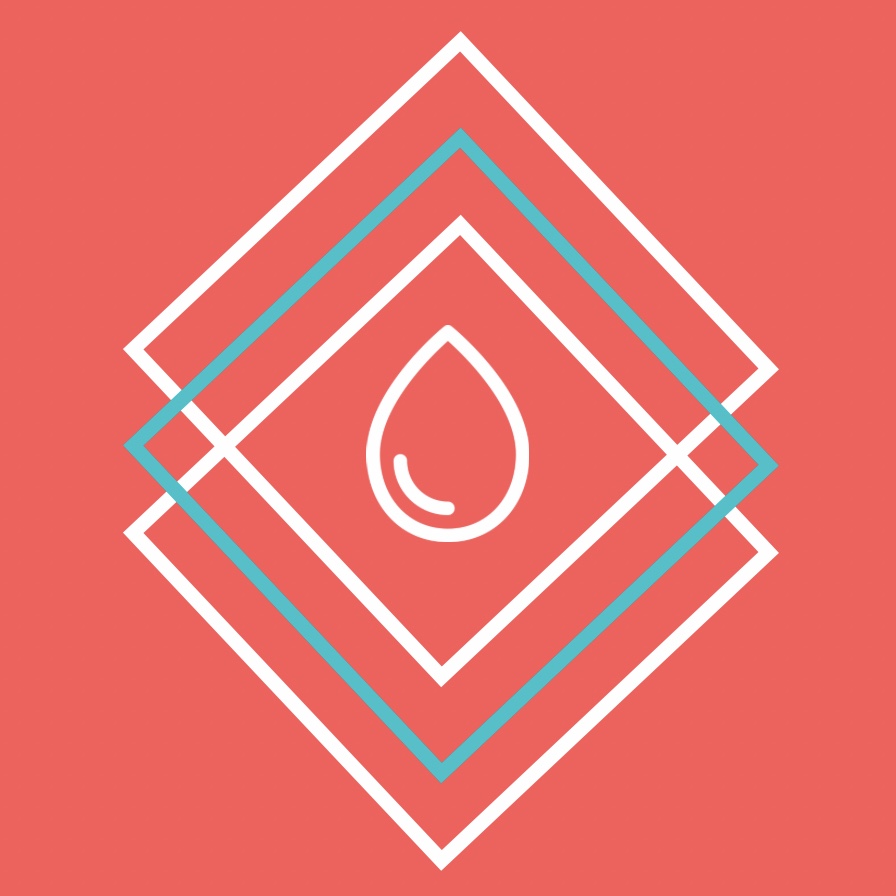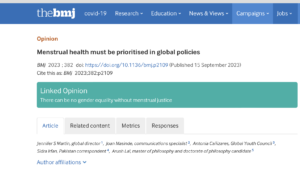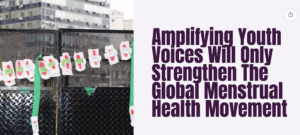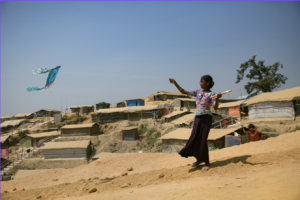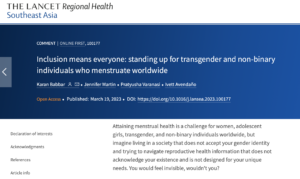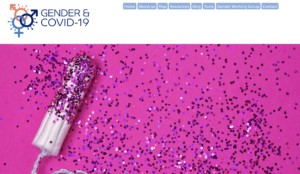The COVID-19 pandemic has further broadened the gender gap, exacerbated the discriminatory social norms, and heightened vulnerabilities that hinder access to essential services2. It has also put untold pressure on overburdened healthcare systems and healthcare workers worldwide – approximately 70% of the global health workforce are women8. Although we appreciate that not all women menstruate and not everyone who menstruates is a woman, we can agree that most of that workforce is working in an environment that does not make provisions for their menstrual health.
The International Labor Organizations (ILO) Convention on the Elimination of all Forms of Discrimination against Women (CEDAW) was adopted by 189 member states in 1979 and is the most important human rights treaty for women in the workplace. Article 3 of CEDAW:
States Parties shall take in all fields, in the political, social, economic and cultural areas, all appropriate measures, including legislation, to ensure the full development and advancement of women to guarantee them the exercise and enjoyment of human rights and fundamental freedoms based on equality with men.
In 2019, a United Nations committee reviewed countries’ progress towards the implementation of CEDAW, where they highlighted several important issues, including:
- Ratifying the Istanbul Convention and taking all necessary steps to protect women and girls from gender-based violence
- taking steps to end negative gender stereotypes and promote positive and diverse representations of gender in schools, public campaigns, and the media
- requiring all employers to protect women from sexual harassment in the workplace
The Committee noted that the adherence of all Members States to the nine primary international human rights instrument[1] would enhance the enjoyment by women of their human rights and fundamental freedoms in all aspects of life. Women and adolescent girls are in the majority when it comes to individuals that menstruate. There are approximately 1.8 billion girls, women, transgender men, and non-binary individuals who menstruate around the world every month 1. Yet their right to menstrual health is not included in the CEDAW.
Does this indicate a more profound issue around shame and stigma or merely a lack of prioritisation of a bodily function that people that menstruate have been “dealing with” discreetly for generations? Nonetheless, it raises the question of how women can fully participate in the workplace if their menstrual needs are not understood or even recognised by employers, labour organisations, unions, communities, or even their colleagues.
The definition of menstrual health (2021) is described as ‘‘a state of complete physical, mental, and social well-being and not merely the absence of disease or infirmity, about the menstrual cycle’ Provisioning for menstrual health involves providing appropriate, affordable, and safe products, hygiene facilities and private spaces to manage periods, and addressing stigma and shame relating to menstruation in the environment.
Around 500 million women and adolescent girls cannot manage their menstrual health in a safe, dignified, and healthy way. When menstrual health needs go unmet, this negatively impacts the lives of individuals that menstruate by restricting mobility, freedom, and choices; compromising safety; causing stress and anxiety; and preventing their equal participation in school, community life, and work 4–7.
Periods do not stop for work, but if workplaces do not provide environments that support menstrual health, their workers will experience disruptions in productivity, an even more stressful work environment, and potentially absenteeism.
Menstrual health challenges of healthcare workers during the COVID-19 pandemic have been exacerbated because period products were not determined ‘essential’9, and personal protective equipment (PPE)10 was not designed so those wearing it could manage their periods. This led to many frontline workers resorting to controlling their periods by taking oral contraceptives to delay their menstruation, wearing nappies or multiple products, or simply bleeding into their PPE while providing care to the patients11.
Female healthcare workers worldwide have voiced concern9 over the lack of prioritisation of menstrual health during the pandemic12. Sharing her experience, a nurse in Uganda described sitting through her period as she bled into her PPE whilst working9. Similarly, in Nepal, a midwife reported bleeding through her PPE during her field shift and had to leave the front lines9. Menstruation is still taboo in many societies, and these experiences could have been traumatic experiences for these women. Furthermore, wearing the same period products for too long may put these women at risk of developing infections and other healthcare13.
Menstrual health is central to the equality, rights, and dignity of women, adolescents, transgender men, and non-binary individuals that menstruate. Those that work in healthcare facilities which are delivering essential services deserve to have their basic needs met, and we believe that this can be achieved through the following:
1. Period products should be included in the list of essential PPE.
Period products and facilities, privacy and time to manage periods should be deemed essential PPE4. We also believe that they need to be given sufficient breaks to manage their periods. Bathrooms should be equipped with products, running water and soap, and there should be bins in the stalls so privacy can be preserved. This would ensure that healthcare workers and other healthcare facility workers who menstruate can access these items when needed during work. Moreover, for non-healthcare workers, it would mean that lockdowns would not disrupt their ability to access period products due to a lack of supply.
2. Designing PPE for periods
When PPE is ill-fitting, or it is not being worn properly, this can lead to periods where its effectiveness is reduced.Reduced effectiveness puts both patients and healthcare workers at risk. PPE must be designed to account for the “human factor” of delivering healthcare. This means planning it to meet the needs of those wearing it – one of those needs is managing periods! PPE must be designed so that healthcare workers can manage their periods.
3. PPE is a gender equity issue
Several voices have been raised against the structure of PPEs, which are men-friendly and “unfit for women”20. At the same time, most of the frontline workers in global health are women, indicating power differences and a colonial practice in global health. In a recent report published by Women in Global Health, only 14% of the surveyed respondents had exclusively used PPE that was fitted to them21. If PPE design does not address diversity, different body and face shapes, and range of headdresses, people who menstruate and deliver healthcare services will face added risks of contracting infections, thereby hindering progress in combatting the COVID-19 pandemic.
4. We are raising awareness of periods in healthcare workers’ workplaces.
Healthcare employers should create a workplace culture where healthcare workers can openly discuss their menstrual health and concerns. This may include addressing confusion or misunderstanding around the menstruation process, whom it affects, and the challenges that can be faced when they do not have what they need to attain menstrual health. This knowledge-building could support healthcare workers that do not menstruate to understand and respect the needs of those that do and build social consciousness. It may also encourage those that menstruate to advocate for their right to menstrual health in the workplace and beyond. Finally, it would address stigma and shame relating to periods.
5. Amending Article 3 – Conversion on the Elimination of all Forms of Discrimination against Women
Everyone has the right to attain menstrual health – menstrual health is health, and health is a human right. We want to call on the International Labor Organizations (ILO) to amend Article 3 of the Convention on the Elimination of all Forms of Discrimination against Women (CEDAW) by adding reproductive rights across the life course (including menstruation, peri-menopause, menopause, and post-menopause) to the list of human rights. Reproductive health and rights beyond pregnancy need to be protected in the workplace and should be covered by CEDAW.
Conclusion
The COVID-19 pandemic has exacerbated the gender inequalities and structural challenges driving poor menstrual health. There is evidence that indicates the failure of global health during the COVID-19 pandemic to protect gender equity among healthcare workers.
Gender equity in global health is not a “women’s issue” but is central to strengthening health systems and global health security. It is thus pertinent to provide them with the means – decent work, safety, dignity, fair pay, and equal leadership – to deliver the best possible health services for everyone. To achieve health and equality for all, we can no longer stigmatise or neglect the needs of those who menstruate. As a Collective, we suggest that it is time for menstrual health in the healthcare workforce to receive attention, the priority it deserves in the realm of global health, and investments that are commensurate with its importance in the lives of those delivering care on the frontlines of COVID-19.
[1] The International Covenant on Economic, Social and Cultural Rights; the International Covenant on Civil and Political Rights; the International Convention on the Elimination of All Forms of Racial Discrimination; the Convention on the Elimination of All Forms of Discrimination against Women; the Convention against Torture and Other Cruel, Inhuman or Degrading Treatment or Punishment; the Convention on the Rights of the Child; the International Convention on the Protection of the Rights of All Migrant Workers and Members of Their Families; the International Convention for the Protection of All Persons from Enforced Disappearance; and the Convention on the Rights of Persons with Disabilities.
References
1 UNICEF. Menstrual hygiene. Water, Sanitation and Hygiene. https://www.unicef.org/wash/menstrual-hygiene (accessed Feb 24, 2022).
2 Babbar K, Martin J, Ruiz J, Parray AA, Sommer M. Menstrual health is a public health and human rights issue. The Lancet Public Health 2021; 0. DOI:10.1016/S2468-2667(21)00212-7.
3 Hashmi N, Ullah I, Tariq SR, et al. How is the COVID-19 pandemic affecting women’s menstrual cycles and quality of life? A view from South Asia. BJPsych Advances 2021; : 1–4.
4 MacRae ER, Clasen T, Dasmohapatra M, Caruso BA. “It’s like a burden on the head”: Redefining adequate menstrual hygiene management throughout women’s varied life stages in Odisha, India. PLOS ONE 2019; 14: e0220114.
5 Sommer M, Sahin M. Advancing the global agenda for menstrual hygiene management for schoolgirls. American Journal of Public Health 2013; 103: 1556–9.
6 van Eijk AM, Sivakami M, Thakkar MB, et al. Menstrual hygiene management among adolescent girls in India: A Systematic review and meta-analysis. BMJ Open 2016; 6. DOI:10.1136/bmjopen-2015-010290.
7 Alam MU, Luby SP, Halder AK, et al. Menstrual hygiene management among Bangladeshi adolescent schoolgirls and risk factors affecting school absence: Results from a cross-sectional survey. BMJ Open 2017; 7. DOI:10.1136/bmjopen-2016-015508.
8 Boniol M, Mclsaac M, Xu L, Wuliji T, Diallo K, Campbell J. Gender equity in the health workforce: Analysis of 104 countries. Geneva, 2019 https://apps.who.int/iris/bitstream/handle/10665/311314/WHO-HIS-HWF-Gender-WP1-2019.1-eng.pdf?ua=1 (accessed Sept 19, 2021).
9 Beenden A. Health Workers Around the World Are Calling for Period Products to Be Considered Essential PPE. Global Citizen 2020; published online May 29. https://www.globalcitizen.org/de/content/health-care-workers-period-poverty-covid-19/?template=next (accessed Sept 19, 2021).
10 Yamakoshi B, Burgers L, Barrington D, et al. Mitigating the impacts of COVID-19 and menstrual health and hygiene. 2020 https://apps.who.int/iris/bitstream/handle/10665/311314/WHO-HIS-HWF-Gender-WP1-2019.1-eng.pdf?ua=1 (accessed Feb 24, 2022).
11 Water for Women Fund. Periods don’t stop in Pandemics: menstrual health in the time of COVID-19. Water for Women Fund. 2020; published online May 28. https://www.waterforwomenfund.org/en/news/periods-dont-stop-in-pandemics-menstrual-health-in-the-time-of-covid19.aspx (accessed Sept 19, 2021).
12 The New Indian Express. Menstrual woes among healthcare workers rise due to coronavirus. The New Indian Express. 2020; published online Sept 16. https://www.newindianexpress.com/cities/delhi/2020/sep/16/menstrual-woes-among-healthcare-workersrise-due-to-coronavirus-2197521.html (accessed Feb 24, 2022).
13 Odey GO, Amusile O, Oghenetejiri PO, David S, Adi A, Lucero-Prisno DE. Period during a pandemic: The neglected reality of Nigerian girls and women. Public Health in Practice 2021; 2: 100196.
14 Rahman HZ, Das N, Matin I, et al. Livelihoods, Coping and Support During Covid-19 Crisis. Dhaka, 2020 https://bigd.bracu.ac.bd/wp-content/uploads/2020/06/PPRC-BIGD-Final-April-Survey-Report.pdf (accessed July 29, 2021).
15 PLAN International. Periods in a Pandemic: Menstrual hygiene management in the time of COVID-19. Texas, 2020 https://reliefweb.int/sites/reliefweb.int/files/resources/mhm_report.pdf (accessed Feb 24, 2022).
16 Sweden Sverige, Water Aid. Menstrual Health and Hygiene: Challenges associated with the COVID-19 pandemic in Bangladesh. Dhaka, 2020 https://reliefweb.int/sites/reliefweb.int/files/resources/Report-%20MHH%20-%20Challenges%20Associated%20to%20COVID-19%20Pandemic%20in%20Bangladesh-.pdf (accessed Sept 19, 2021).
17 Khan M, Abimbola S, Aloudat T, Capobianco E, Hawkes S, Rahman-Shepherd A. Decolonising global health in 2021: a roadmap to move from rhetoric to reform. BMJ Global Health 2021; 6: e005604.
18 Kwete X, Tang K, Chen L, et al. Decolonizing global health: what should be the target of this movement, and where does it lead us? Global Health Research and Policy 2022; 7: 3.
19 Babbar K, Dev P. COVID-19 and Period Products Usage among Menstruating Women in Urban and Rural India. Ahmedabad, 2021 https://web.iima.ac.in/assets/snippets/workingpaperpdf/2497601962021-11-03.pdf (accessed Feb 24, 2022).
20 Owings L. Medical PPE unfit for women on COVID-19 frontlines. SciDev.Net. 2021; published online Nov 25. https://www.scidev.net/global/news/medical-ppe-unfit-for-women-on-covid-19-frontlines/ (accessed Feb 24, 2022).
21 Women in Global Health. Fit for Women? Safe and Decent PPE for Women Health and Care Workers. 2021 https://www.womeningh.org/_files/ugd/ffa4bc_127fbd76602a4eefb5bb34be5fdd269f.pdf?index=true (accessed Feb 24, 2022).
